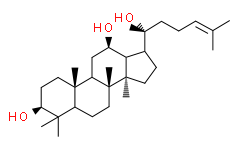| Cas No.: | 7755-01-3 |
| Chemical Name: | Protopanaxadiol |
| Synonyms: | Protopanaxadiol;20R-Betulafolienetriol;(20R)-5α-Dammar-24-ene-3β,12β,20-triol;(20R)-Dammar-24-ene-3β,12β,20-triol;(20R)-Protopanaxadiol;20R-Protopanaxadiol;PROTOVERATRINE A+B (RG)(CALL);20(R)-Protopanaxadiol;Protopanaxdiol;Protopanoxadiol;20(R)Protopanaxdiol;Dammar-24-ene-3b,12b,20-triol, (20R)- (8CI);Protopanaxadiol (7CI);20(R)-APPD;(8R,9R,10R,14S)-17-[(2R)-2-Hydroxy-6-methylhept-5-en-2-yl]-4,4,8,10,14-pentamethyl-2,3,5,6,7,9,11,12;(20R)-Protopanaxdiol;20(S)-protopanaxadiol;P6717R7BP8;20(R)-Protopanaxdiol;HY- |
| SMILES: | O([H])[C@]1([H])C([H])([H])[C@]2([H])[C@@]3(C([H])([H])[H])C([H])([H])C([H])([H])[C@@]([H])(C(C([H])([H])[H])(C([H])([H])[H])[C@]3([H])C([H])([H])C([H])([H])[C@@]2(C([H])([H])[H])[C@]2(C([H])([H])[H])C([H])([H])C([H])([H])[C@]([H])([C@@](C([H])([H])[H])(C([H])([H])C([H])([H])/C(/[H])=C(\C([H])([H])[H])/C([H])([H])[H])O[H])[C@]21[H])O[H] |
| Formula: | C30H52O3 |
| M.Wt: | 460.7321 |
| Purity: | >98% |
| Sotrage: | 2 years -20°C Powder, 2 weeks 4°C in DMSO, 6 months -80°C in DMSO |
| Description: | (20R)-Protopanaxadiol is a triterpenoid saponin metabolite of 20(R)-ginsenoside Rg3 in black ginseng. (20R)-Protopanaxadiol exhibits anti-tumor activity and cytotoxicity, and potently inhibits the growth of Helicobacter pylori[1][2][3]. |
| References: | [1]. Liu L, et al. Enzymatic preparation of 20(S, R)-protopanaxadiol by transformation of 20(S, R)-Rg3 from black ginseng. Phytochemistry. 2010 Sep;71(13):1514-20. [2]. Bae EA, et al. Metabolism of 20(S)- and 20(R)-ginsenoside Rg3 by human intestinal bacteria and its relation to in vitro biological activities. Biol Pharm Bull. 2002 Jan;25(1):58-63. [3]. Hasegawa H, et al. Inhibitory effect of some triterpenoid saponins on glucose transport in tumor cells and its application to in vitro cytotoxic and antiviral activities. Planta Med. 1994 Jun;60(3):240-3. |






















